Multiple Choice
Identify the
choice that best completes the statement or answers the question.
|
|
|
1.
|
Literal Reading Comprehension—Reading Directions--RIT 201 -
210
Read the
recipes.
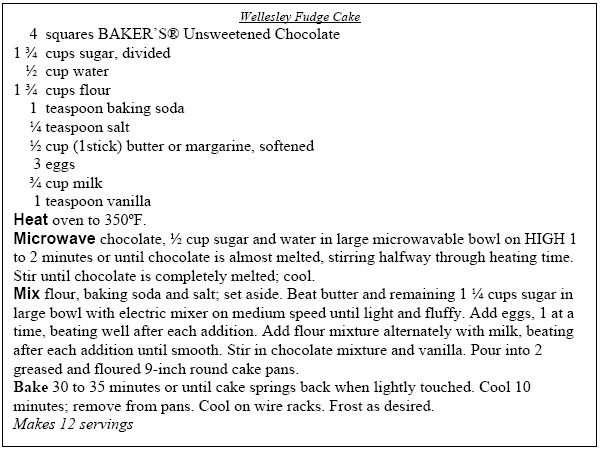
Copyright Info: For Chocolate
Lovers Only. Publication International, Ltd. 1996. Lincolnwood, IL 60712. Page
250.
What type of chocolate is suggested for this recipe?
a. | Baker’s
Unsweetened | c. | Ghirardelli
Dark | b. | Hershey’s Milk | d. | Drste Cocoa |
|
|
|
2.
|
Read the
recipe.
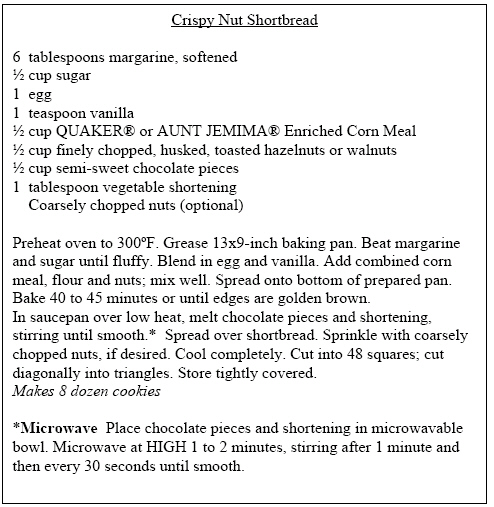 Copyright Info: Great-Tasting
Cookies and Candies, Page 358. (Phillips, Felts, Blackman). Copyright Info: Great-Tasting
Cookies and Candies, Page 358. (Phillips, Felts, Blackman).
If you
choose not to bake this recipe, what alternative cooking method is
recommended?
a. | dutch oven
cooking | c. | convection oven
cooking | b. | microwave cooking | d. | stove top cooking |
|
|
|
3.
|
Read the
label.
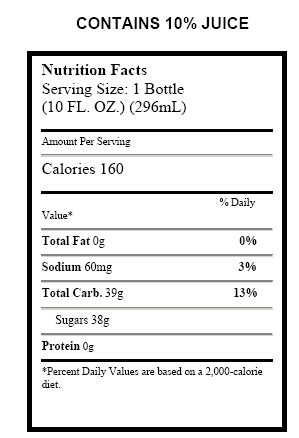 Copyright Info:
2001 Welch’s
Concord, MA 01742 Copyright Info:
2001 Welch’s
Concord, MA 01742
What percentage of this product is
juice?
a. | contains 13%
juice | c. | contains 10%
juice | b. | contains 0% juice | d. | contains 3% juice |
|
|
|
4.
|
Read the
label.
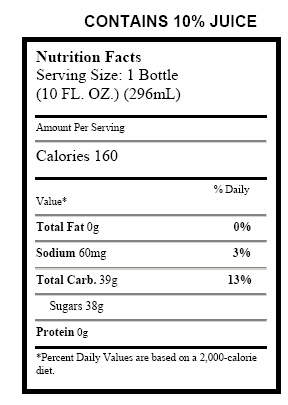 Copyright Info:
2001 Welch’s
Concord, MA 01742 Copyright Info:
2001 Welch’s
Concord, MA 01742
How many servings does this product
contain?
|
|
|
5.
|
Read the
directions.
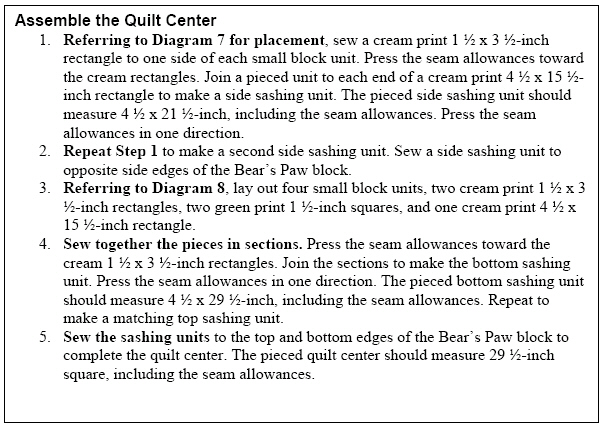
Copyright Info: None Given (Phillips, Felts,
Blackman)
What should the measurements be of the bottom sashing
unit?
a. | 4 x 29
inches | c. | 4 x 15
inches | b. | 1 x 3 inches | d. | 4 x 21 inches |
|
|
|
6.
|
Read the
passage.
Once the flower buds
are formed, it doesn’t matter if the plant is kept indoors or in deep shade. Full sun tends to
fade the flowers faster, while cool temperatures prolong their staying power. Although a light frost
won’t harm most mums, play it safe and bring them indoors if a cold snap threatens.
In
the passage, the phrase “full sun” means:
Copyright
Info: “Mums the Word.” First for Women 30 Sept. 2002:
86.
a. | no
shade | c. | deep
shade | b. | light half of the day | d. | cool temperatures |
|
|
|
7.
|
Read the
passage.
“A few days
before leaving, make up a checklist of what you intend to take,” advises McAlpin. A day or two
later, revise the list and cut it down. Then, as you pack, check off each item as you go. “Keep
this checklist and use it as a guide for you r next getaway,” she says. “Build your
wardrobe using one or two basic colors so that the same shoes and accessories can be worn with pretty
much every thing,” recommends McAlpin. She suggests the combinations of black
and white,
brown and beige, or black and beige. Also pack items that are multipurpose. For example, a large
T-shirt can double as a nightgown and a beach cover-up; flip flops can double as slippers and casual
shoes. “And make sure each item can be worn with at least two outfits.”
Copyright Info: “Four Secrets to Taking the ‘Lug’ out
of Luggage.” First for Women 30 Sept. 2002: 111.
Why do the directions say to
include one or two basic colors in your wardrobe selection?
a. | Items can be worn with most
everything. | c. | Items are easier
to pack. | b. | Items provide for sameness in attire. | d. | Items can be washed in one load. |
|
|
|
8.
|
Literal Reading Comprehension—Reading for Detail--RIT 201 -
210
1. Read the passage.
At the very time of the
humiliation at Fort Duquesne—when George Washington, Daniel Boone, and General Edward Braddock
were defeated by French and Indian foes—a Mohawk Indian was readying himself for a
warriors’ dance. The Mohawk—name Warraghiyagey (war-rag-ee- YAH-gay)—painted bright
designs on his naked chest, stepped into a deerskin kilt adorned with porcupine quills, and donned a
cap topped with a single eagle feather. Tied to his wrists and
ankles were dried deer’s
hoofs that rattled as he moved. He ate of ceremonial dog meat and threw a red-painted hatchet onto a
war post. Soon he would lead the strenuous dance.
Copyright Info:
Hakin, Joy. From Colonies to Country: 1710-1791. Book 3, Second Edition. Oxford University Press,
1999.
In the last three sentences to whom does “he”
refer?
a. | Fort
Duquesne | c. | George
Washington | b. | Daniel Boone | d. | Warraghiyagey |
|
|
|
9.
|
Read the
passage.
Wolves are
carnivorous, predatory animals. They live together in packs with an alpha male who is the dominant
leader. Wolves hunt mostly at dusk, and they prey on elk, deer, coyotes, rabbits, and other animals
in their habitat. Sometimes, they even prey on moose.
What is the alpha
male?
a. | the
pack | c. | the
prey | b. | the leader | d. | the elk |
|
|
|
10.
|
Read the
passage.
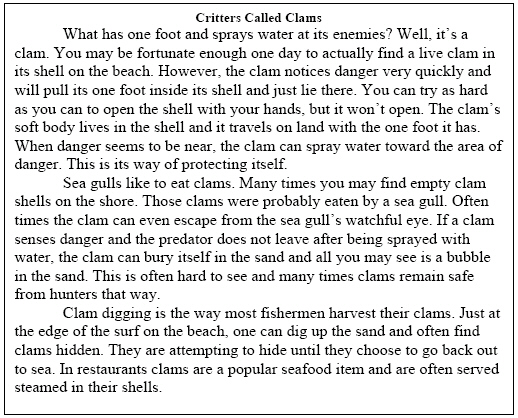 Copyright Info:
Reading Achievement. Carson-Dellosa Pub., Grade 5, 2001. Copyright Info:
Reading Achievement. Carson-Dellosa Pub., Grade 5, 2001.
What is
the clam’s body like?
a. | soft | c. | salty | b. | hard | d. | bumpy |
|
|
|
11.
|
Literal Reading Comprehension—Sequencing--RIT 201 -
210
Read the
passage.
[Mother] went back to work, closing the door. At first the sound of the boy
dragging brush annoyed her. Then he began to chop. The blows were rhythmic and steady, and shortly
she had forgotten him, the sound no more of an interruption than a consistent rain. She supposed an
hour and a half passed, for when she stopped and stretched, and heard the boy’s steps on the
cabin stoop, the sun was dropping behind the farthest mountain, and the valleys were purple
with
something deeper than the asters.
Copyright Info:
Rawlings, Marjorie Kinnan.
“A Mother in Manville.” Living in the Heart.
After
the boy dragged the brush, what did he do?
a. | He began to
chop. | c. | He watched the
sunset. | b. | He began to stretch . | d. | He listened to the rain. |
|
|
|
12.
|
Read the
sentences.
a. Then, I fell
twice, hard, once dropping my gun.
b. Later, we flushed a covey of qual and I killed two over the
bank.
c. It was a bright, cold day, and the ground covered with a sleet that had frozen.
d. I
took the young Irish Setter for a little walk up the road.
If these sentences made a story,
which events would occur first and last?
|
|
|
13.
|
Read the
paragraph.
A few days ago Craig
cleaned up the garage, and checked the tire pressure on his bike. Yesterday he washed his clothes.
This morning he had to study. He studied from 10:00a.m. to 2:30p.m. He has to play basketball at
6:00p.m.
According to this paragraph, which statement is true?
a. | Craig hasn’t washed his
clothes. | c. | Craig will play
basketball at 6:00p.m. | b. | Craig has to go to the dentist tomorrow. | d. | Craig only studied for 2 hours. |
|
|
|
14.
|
Read the
passage.
…[T]he more he labored, the more difficult his task became. From the
stump of each head that he cut off, two other heads, with forked and hissing tongues, immediately
sprang. Faced with an endless and increasing effort, Hercules was at a loss [for] what to
do. It seemed to him that heat might prove more powerful than cold steel, and he commanded [his
friend] to burn the root of each head with a red-hot iron immediately after it was severed from
the neck. This plan was
successful. The heads no longer sprouted up again, and soon the dangerous
and destructive animal lay dead, though still writhing in the black marsh water among the reeds.
Hercules cut its body open and dipped his arrows in the blood.
Copyright Info: Warner, Rex. “The Labors of Hercules.” 543.
(Phillips, Felts, Blackman).
Choose the correct order of
events.
a. | cut off the head, two more heads
sprouted, burned the root of each head, dipped his
arrows in the
blood | c. | burned the root of each head, cut
off the head, two more heads sprouted, dipped his arrows
in the
blood | b. | two heads sprout, dipped his arrows in blood, cut off the head, burned the
root of each head | d. | dipped his arrows in blood, two more
heads sprouted, cut off the head, burned the root of
each
head |
|
|
|
15.
|
Read the
passage.
When I had made an end of these labors, it was four o’clock—still dark as
midnight. As the bell sounded the hour, there came a knocking at the street door. I went down to open
it with a light heart—for what had I now to fear? There entered three men, who introduced
themselves, with perfect suavity, as officers of the police. A shriek had been heard by a neighbor
during the night; suspicion of foul play had been aroused; information had been lodged at the police
office, and they (the officers) had been deputed to search the premises.
Copyright Info: Poe, Edgar Allan. “The Tell-Tale Heart.” ( Phillips, Blackman,
Felts).
What happens next?
a. | The police search the
house. | c. | The police arrest the
man. | b. | The police leave the man’s house. | d. | The police ask for information. |
|
|
|
16.
|
Read the passage.
One
morning less than a week before their bout, they met as usual for their daily workout. They fooled
around with a few jabs at the air, slapped skin, and then took off, running lightly along the dirty
East River’s edge.
When they met for their workout, what was the first thing they
did?
Copyright Info: Thomas, Piri. Stories from El Barrio. 1978.
(Phillips, Blackman, Felts).
a. | They jabbed into the
air. | c. | They went for a
run. | b. | hey slapped each other. | d. | They jumped rope. |
|
|
|
17.
|
Read the
passage.
It looked like the end
of Jason’s journey, and Amy was in tears as she climbed out of the plane. The principal of the
Institute and his wife, Mr. and Mrs. Shaw, brought Amy into their house and gave her some clean
clothes; she had a bath and a meal, and then they went, carrying huge umbrellas, out into the rainy
night, to look at Jason. They had to cross the field which was like a sea of mud: mud which had
probably saved the plane from an even worse crash by slowing it down a bit.
Copyright Info: King, Clive. “Amy Johnson, Queen of the
Air.” Adventure Stories. New York: Kingfisher Books. 221.
What did Amy and the
Shaw’s do after Amy’s bath and meal?
a. | They went out to look at the
Jason. | c. | They brought Amy into their
house. | b. | They comforted Amy as she cried. | d. | They climbed out of the plane. |
|
|
|
18.
|
Read the
passages.
Thomas practiced his
piano Monday through Friday for 45 minutes each day. On Monday, he practiced at 5:30 a.m. On Tuesday,
he practiced at 8:00 a.m. On Wednesday, he practiced right before breakfast. On Thursday, he
practiced after school, but before soccer. On Friday, he practiced at 6:00 a.m. and then again at
2:30 p.m. Angie practiced her piano Monday, Tuesday, Thursday, Friday and Saturday for 45 minutes
each. On Monday, she practiced after dinner. On Tuesday, she practiced at 6:30 a.m. She skipped
Wednesday and practiced on Thursday at 6:00 a.m. and then again at 8:00 a.m. On Friday, she practiced
at 3:30 p.m. Then, on Saturday, she practiced at 2:00 p.m.
Who put in the most time practicing
in the morning?
a. | Angie practiced three more
times. | c. | Thomas practiced less
time. | b. | Thomas practiced one more time. | d. | Angie practiced one more time. |
|
|
|
19.
|
Read the
passage.
Mafatu opened one of
the green drinking nuts and tilted back his head to let the cool liquid trickle down his parched
throat; more refreshing than spring water, cool on the hottest days, and as sustaining as food. The
boy scooped out the gelatinous meat for Uri and the dog ate it gratefully.
Copyright Info: Sperry, Armstrong. Call It Courage. New York: Macmillan
Publishing Co. 23.
After Mafatu drank, what did he do for his
dog?
a. | He gave him a
drink. | c. | He fed
him. | b. | He petted him. | d. | He played with him. |
|
|
|
20.
|
Choose the best
answer.
You will be making
twenty squares, ten each of two different fabric combinations. Before you start sewing, coordinate
fabrics for each combination. Keep track of combinations and use assembly-line sewing as you go. For
each step, position pieces right sides together and line up all sets next to your sewing machine.
Stitch first set together, then continue sewing without breaking your thread. Cut threads and press
seams.
What do you do before you begin sewing?
a. | coordinate
fabrics | c. | cut
threads | b. | position pieces | d. | press seams |
|
|
|
21.
|
Read the
passage.
I’m not sure I
can tell you what you want to know about my brother; but everything about the pet fox is important,
so I’ll tell all that from the beginning. It goes back to a winter afternoon after I’d
hunted the woods all day for a sign of our lost pet.
I remember the way my mother looked up as I
came into the kitchen. Without my speaking, she knew what had happened. For six hours I had walked,
reading signs, looking for a delicate print in the damp soil or even a hair that might have told of a
red fox passing that way—but I had found nothing.
Copyright
Info: Annixter, Paul. “Last Cover.” 57. (Phillips, Felts,
Blackman).
What was the first event that occurred?
a. | He talked to his
mother | c. | He looked for a print in the
soil. | b. | He found a pet fox. | d. | He walked for six hours. |
|


